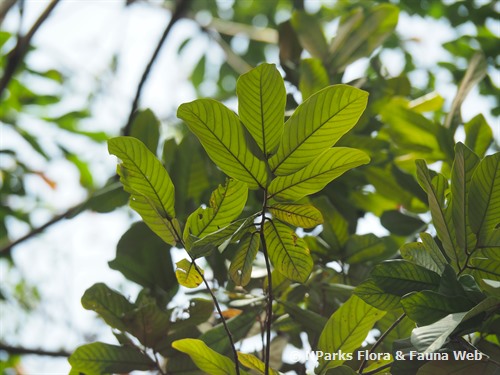
Back
Hopea coriacea Burck
| Family Name: | Dipterocarpaceae |
| Synonyms: | Hopea garangbuaya P.S.Ashton, Hopea kelantanensis Symington |
| Common Name: | Giam Hantu, Damar Melapi, Garang Buaya, Arang Bayar |
Name
Classifications and Characteristics
| Plant Division | Angiosperms (Flowering Seed Plants) (Dicotyledon) |
|---|---|
| Plant Growth Form | Tree |
| Lifespan (in Singapore) | Perennial |
| Mode of Nutrition | Autotrophic |
| Plant Shape | Irregular |
Biogeography
| Native Distribution | Peninsular Malaysia and Borneo. |
|---|---|
| Native Habitat | Terrestrial (Primary Rainforest, Secondary Rainforest, Riverine) |
| Preferred Climate Zone | Tropical |
| Local Conservation Status | Non-native (Horticultural / Cultivated Only) |
Description and Ethnobotany
| Growth Form | It is a tall tree with flaky or fissured-bark. |
|---|---|
| Foliage | Its stalked, alternately-arranged leaves are thick and leathery, broadly ovate, and 11-16 cm by 6-10 cm. The leaf margins are slightly curved in. |
| Flowers | Its flowers are five-petaled. Each petal is narrow-lanceolate, about 1.3 cm long. The flowers are borne on a stalked inflorescence. |
| Fruit | Its fruits are winged nuts. The spatulate 'wings' are formed from two of the longer lobes of the persistent calyx, about 7 cm long and 1.5 cm wide. The ovoid nut is about 1.8 cm by 0.9 cm, enclosed by the remaining shorter calyx lobes. |
| Habitat | It grows in lowland forests, along sandy river banks. |
| Associated Fauna | Its flowers are pollinated by insects. |
| Cultivation | It can be propagated by seed. |
| Etymology | Latin Hopea, after Dr John Hope (1725–86), Scottish botanist of the Edinburgh Botanic Garden; Latin coriacea, thick, tough, and leathery, referring to the leaves of this species. |
Landscaping Features
| Landscaping | It is suitable for growing in parks. |
|---|---|
| Desirable Plant Features | Ornamental Fruits |
| Landscape Uses | Parks & Gardens, Riverine |
Fauna, Pollination and Dispersal
| Pollination Method(s) | Biotic (Fauna) |
|---|---|
| Seed or Spore Dispersal | Abiotic (Gravity) |
Plant Care and Propagation
| Light Preference | Full Sun, Semi-Shade |
|---|---|
| Water Preference | Moderate Water |
| Plant Growth Rate | Moderate |
| Rootzone Tolerance | Moist Soils, Well-Drained Soils, Fertile Loamy Soils |
| Maintenance Requirements | Moderate |
| Propagation Method | Seed |
Foliar
| Foliage Retention | Evergreen |
|---|---|
| Mature Foliage Colour(s) | Green |
| Mature Foliage Texture(s) | Leathery, Thick |
| Foliar Type | Simple / Unifoliate |
| Foliar Arrangement Along Stem | Alternate |
| Foliar Attachment to Stem | Petiolate |
| Foliar Shape(s) | Non-Palm Foliage (Ovate) |
| Foliar Venation | Pinnate / Net |
| Foliar Margin | Entire |
| Foliar Apex - Tip | Acuminate |
| Foliar Base | Rounded / Obtuse |
Floral (Angiosperm)
| Flower & Plant Sexuality | Bisexual Flowers |
| Flower Colour(s) | Cream / Off-White, White |
|---|---|
| Flower Grouping | Cluster / Inflorescence |
| Flower Location | Axillary |
| Flower Symmetry | Radial |
| Inflorescence Type | Panicle |
Fruit, Seed and Spore
| Mature Fruit Colour(s) | Brown |
|---|---|
| Fruit Classification | Simple Fruit |
| Fruit Type | Indehiscent Dry Fruit , Nut / Nutlet |
Image Repository
Others
| Master ID | 31678 |
|---|---|
| Species ID | 6077 |
| Flora Disclaimer | The information in this website has been compiled from reliable sources, such as reference works on medicinal plants. It is not a substitute for medical advice or treatment and NParks does not purport to provide any medical advice. Readers should always consult his/her physician before using or consuming a plant for medicinal purposes. |




